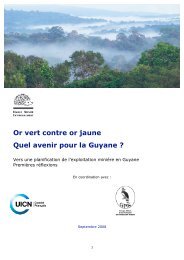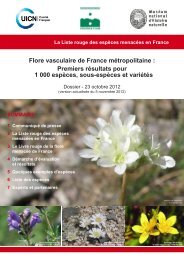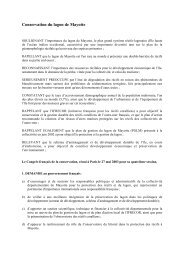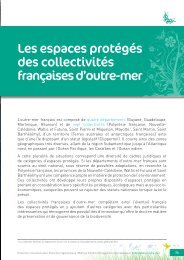Establishing Marine Protected Area Networks - Georgia Strait Alliance
Establishing Marine Protected Area Networks - Georgia Strait Alliance
Establishing Marine Protected Area Networks - Georgia Strait Alliance
You also want an ePaper? Increase the reach of your titles
YUMPU automatically turns print PDFs into web optimized ePapers that Google loves.
WHY DO WE NEED MPA NETWORKS?<br />
The best available scientific information tells us that, to protect<br />
biodiversity and manage resources, we must establish representative<br />
MPA networks across 20 to 30 percent of our seas and oceans.These networks<br />
may have different uses and levels of protection within them, but all should include<br />
reserves or no-take areas and should include representative examples of the<br />
different ecosystems, habitats and communities in our seas and oceans.<br />
Yet most countries and regions have only just started to develop small MPAs,<br />
and many have only one or a few MPAs. It is unrealistic to expect that building<br />
MPA networks can be achieved in a single step. Instead, planners should expect<br />
to develop a gradual strategy for implementing a full network.<br />
In the beginning, countries and regions may want to focus on developing a few<br />
well-managed MPAs that benefit local communities.These areas can be used to<br />
model the benefits of the larger network for decision makers and the public at<br />
large.At all times, however, MPA networks must be viewed realistically and in<br />
context; they cannot solve broader deficiencies in ocean governance or management.<br />
What is an mpa ‘network’?<br />
An MPA network is an organized collection of individual<br />
sites, designed to link individual areas and to<br />
comprehensively represent the region’s spectrum<br />
of marine life characteristics. International commitments<br />
to MPA networks recognize that they fulfill<br />
ecological and social aims that a single MPA alone<br />
cannot. Given the difficulty of coordinating actions<br />
among many countries at once, a global system<br />
of MPAs will most likely consist of national and<br />
regional networks distributed across the globe.<br />
An MPA network can therefore be defined as:<br />
A collection of individual marine protected<br />
areas operating cooperatively and synergistically,<br />
at various spatial scales, and with a range of<br />
protection levels, in order to fulfil ecological<br />
aims more effectively and comprehensively than<br />
individual sites could alone. The network will<br />
also display social and economic benefits, though<br />
the latter may only become fully developed over<br />
long time frames as ecosystems recover.<br />
<strong>Area</strong>s with full protection – that is, areas where no<br />
extractive activities such as fishing or the removal<br />
of resources are permitted – should be part of<br />
every network.These areas act as benchmarks for<br />
assessing the state of the environment and the<br />
success of management regimes; they also contribute<br />
significantly to the recovery and protection of marine<br />
ecosystems.The proportion of fully protected areas<br />
versus less strictly protected areas within a network<br />
will depend on the degree of protection and recovery<br />
being sought and the level of decline in an area’s<br />
marine resources.<br />
Why are mpa networks important for<br />
sustainable development?<br />
MPA networks contribute to sustainable development<br />
goals by fostering integrated ocean and<br />
coastal management.<br />
❏ Ecologically. A network can help to ensure<br />
marine ecosystem function by encompassing the<br />
temporal and spatial scales at which ecological<br />
systems operate.<br />
❏ Socially. A network can help resolve and<br />
manage conflicts in the use of natural resources<br />
and ensure that reasonable uses can occur with<br />
minimal conflict.<br />
❏ Economically. A network facilitates the efficient<br />
use of resources by preventing duplication of effort,<br />
such as when small, individual areas attempt to<br />
maintain their own management resources.<br />
Representative networks of MPAs – those that<br />
contain examples of all habitats and ecological<br />
communities of a given area – also provide a costeffective<br />
means of safeguarding large-scale processes<br />
while delivering local benefits. <strong>Networks</strong> can also<br />
help reduce the degradation of coastal and marine<br />
habitats, slow the loss of endangered marine<br />
species, and restore depleted fisheries.<br />
2 | <strong>Establishing</strong> <strong>Marine</strong> <strong>Protected</strong> <strong>Area</strong> <strong>Networks</strong><br />
<strong>Establishing</strong> <strong>Marine</strong> <strong>Protected</strong> <strong>Area</strong> <strong>Networks</strong> | 3
















